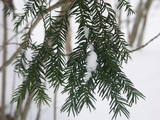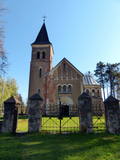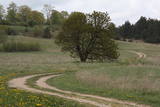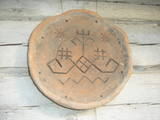| Nr | Nosaukums | Apraksts |
|---|---|---|
|
Sena, lībiešu apdzīvota teritorija jau no 5.- 6. gs. 1226. g. Salacas labajā krastā pie tās ietekas bīskaps Alberts uzcēla pili, kas līdz mūsdienām nav saglabājusies. Arī Salacgrīvas attīstība (līdzīgi kā Ainažiem) ir bijusi saistīta ar ostas izveidi. 19.-20. gs. mijā Salacgrīva kļuva par nozīmīgu Ziemeļvidzemē ražoto preču (īpaši kokmateriālu) pārkraušanas un transporta mezglu. Padomju laikā Salacgrīvas ziemeļu daļā izveidoja Zvejnieku parku ar vienu no labākajiem mazpilsētu stadioniem un brīvdabas estrādi. Šajā laikā visā PSRS mērogā ir pazīstama zivju pārstrādes rūpnīcas „Brīvais vilnis" ražotā produkcija, īpaši – šprotes. Salacgrīva ir viena no divām vietām Latvijā, kur nēģus joprojām zvejo ar seno metodi – taču palīdzību. |
||
|
Ceļa, kas ved uz jūru – galā, redzami Latvijas piekrastei samērā reti skati. Ja palaimējas, šeit var novērot vietējos zvejniekus darbībā, kas joprojām iet zvejā. Krasta kāpās aplūkojamas vecas, pamestas un arī sagrieztas zvejas liellaivas un dažādi mūsdienu zvejniecībā izmantojami „darba rīki”. |
||
|
Restorāns - picērija "Tomato Pica" atrodas Jelgavas pilsētas centrā t/c „Pilsētas Pasāža”. Patīkamai ēdienu baudīšanas noskaņai eleganti un mājīgi iekārtotas restorānu telpas, viegla fona mūzika un laipns, profesionāls personāls. "Tomato Pica" piedāvājumā ir visi klasisko picu veidi, pagatavoti izmantojot īpašas mērces receptes un Itālijai raksturīgu picas mīklu. Kā arī dažādi salāti, uzkodas, zupas, pastas, otrie ēdieni, deserti un dzērieni. "Tomato Pica" restorāns – picērija vienlīdz piemēroti kā atpūtai ģimenes lokā, tā pusdienām biznesa sarunu gaisotnē. |
||
|
Ar mežu klāta teritorija, kas veidota reliktas aizsargājamas augu sugas - parastās īves u.c. augu aizsardzībai. Teritorija nav piemērota apmeklējumiem, jo apmeklētājs bez vides zināšanām šeit ieraudzīs „parastu” mežu.
|
||
|
Alus bārs "Tērvete" atrodas Dobeles vēsturiskajā centrā - Tirgus laukumā. Piedāvā latviešu nacionālo virtuvi un Tērvetes alu, kura ražošanā tiek izmantotas Latvijā audzētas izejvielas. Vasarās - āra terase. Latviešu virtuve: Aukstā zupa, pelēkie zirņi ar speķi, Tērvetes kotletes, Tērvetes rukša stilbs. Īpašais ēdiens: Tērvetes siera kūka. |
||
|
Kazas piena produkti, ēdieni no kazas izcelsmes produktiem, izglītošanās programmas. |
||
|
Gārsenes evanģēliski luteriskā baznīca – baznīcu barons fon Budbergs bija iecerējis kā veltījumu savai mirušajai sievai, anglietei Ģertrūdei Vorsai. Tā celta ap 1905. gadu pēc arhitekta K.fon Engelharta projekta, bet būvdarbus vadīja arhitekts Eduards Kupfers (1873.-1919). Kokmateriāli vesti no tuvējā meža. Jauncelto baznīcu iesvētīja 1906. gada 1. oktobrī. Kopš 1922. gada baznīca pieder Gārsenes ev.lut. draudzei, tās balkonā atrodas Valkera firmas ērģeles, kas būvētas 1906. gadā Ludvigsburgā. Šīfera jumtu baznīcai uzlika 1976.-1979. gadā. 1988. gadā Restaurācijas pārvaldes jumiķi uzlika tornim kapara skārda jumtu. Torņa smailes lodē ielika kapsulu ar vēstījumu par Gārsenes vēsturi. 1991. gadā altāra daļā nokrāsoja griestus un sienas, restaurēja velves uzrakstu: “Nāciet pie manis visi, kas esat bēdīgi un grūtsirdīgi, es jūs gribu iepriecināt”. Blakus baznīcai tika uzbūvēta barona Budberga dzimtas kapliča, kura saglabājusies līdz mūsdienām un ir vietējās nozīmes Kultūrvēsturisks piemineklis.
|
||
|
Saimniecības "Toomemäe" mājas restorānā "Maagõkõnõ" pasniedz vieglu ēdienu ar tīru garšu, kas vēl vecmāmiņu laikos bija ikdiena, bet tagad tiek uzskatīts par gardēžu privilēģiju. Tiek pasniegti tieši šai pusei senāk raksturīgie ēdieni. Izejvielas ir tīras un no tuvākās apkārtnes. |
||
|
Livonijas ordeņa atbalsta punkts, kuru vietējie iedzīvotāji cēla spaidu darbos. Cietoksni iznīcināja pēc Dānijas karaļa Frederika II 1576. g. pavēles. |
||
|
This tour of the Forest Trail covers the national parks of Dzūkija and Žemaitija and the Nemunas Loops Regional Park in Lithuania. The starting point of the route is Druskininkai, a popular SPA and mineral water resort on the banks of the river Nemunas. Here, we recommend dipping yourself in mineral water baths, enjoying the trip with the cable car over the river Nemunas, visiting the musical fountain, and walking along the river promenade. For the next two days from Druskininkai, the Forest Trail passes through the Dzūkija National Park to the town of Merkinė. In this most forested and unpopulated region in Lithuania you can enjoy hiking along solitary forest roads, visit ancient mounds and ethnographic villages, where the traditions of bee-keeping, crafts, mushrooms and berry harvesting are still kept alive. You will then head to Birštonas, one of the key resorts in Lithuania with its valuable mineral waters. The town finds itself in the Nemunas Loops Regional Park, which includes four large and one smaller loops of the river. The Forest Trail stretches from Birštonas through the entire Nemunas Loops Regional Park up till the town of Prienai. Next, hikers will get to Kaunas, the second largest city in Lithuania and its former capital city. Kaunas is notable for its modernist architecture. The catchment area of the river Nemunas and the river Neris is situated here. Heading on, from Lampėdžiai to Vilkija, the Forest Trail runs for two days along trails and small countryside gravel roads next to the right bank of the river Nemunas, also crossing resort territory of Kulautuva. This section is characteristic of beautiful riverscapes, waterfront meadows and small villages. For the final section, first you must get to the Žemaitija National Park, where the Forest Trail runs around the Lake Plateliai, which is the largest lake in the historic Samogitian region. Old pine and fir forests and mixed forests are among the most precious natural values of |
||
|
Krogs "Trīs kambari" atrodas Limbažu vēsturiskajā centrā Blaumaņa Kārļa laukumā. Latviešu virtuve: Aukstā zupa, cepta menca vai bute, gaļas – sēņu podiņš, pildītas pankūkas, rupjmaizes kārtojums, zemeņu zupa. Īpašais ēdiens: „Kāzu karbonāde” (no cūkgaļas). |
||
|
Vēstures avotos pirmoreiz minēta 1483. g. Pilsētas uzplaukums bija vērojams pēc dzelzceļa uzbūvēšanas 19. gs. beigās, kad barons Korfs sadalīja un iznomāja apbūvei muižas zemi. Pilsētas tiesības Priekule ieguva 1928. g. Pilsēta smagi cieta 2. pasaules kara pēdējos mēnešos, - t.s. Kurzemes katla laikā, kuru laikā tika sagrautas 410 no 450 ēkām. Mūsdienās tā ir neliela pilsētiņa ar mazstāvu apbūvi un nesteidzīgu dzīves ritmu. |
||
|
Dabas lieguma teritorijā ir vērojama Kurzemei reti sastopama ainava, kurā atrodas aizsargājams biotops – klajas iekšzemes kāpas ar kāpsmildzenes pļavām, kā arī lapukoku meži, kurā aug parastais skābardis. Tūristi Sventājas ielejas labā krasta nogāzē var apmeklēt Muižas (Leju) svētavotu (kāpjošs avots), virs kura kuplo Latvijas dižākā ieva un izveidota jauka niedru lapene. Pirms avota no ceļa paveras plašs skats uz Sventājas ieleju. |
||
|
Neliela apdzīvota vieta Daugavas krastos starp Aizkraukli un Jaunjelgavu. Skrīveru apkaime saistās ar populārā latviešu rakstnieka A. Upīša gaitām un darbiem. Netālu no Skrīveriem meklējams arī vecākais Latvijas dendrārijs. Tā izveidi 1891. g. uzsācis Skrīveru muižas īpašnieks Maksimilians fon Siverss. Parka dendroloģiskajā klāstā ir ap 400 augu sugu, šķirņu un formu. Viens no lieliskākajiem Daugavas skatiem pavērsies no t.s. Kraukļu kalniem – stāva Daugavas labā pamatkrasta augšdaļas, kas ir sens pilskalns. |
||
|
Dodieties ekskursijā, lai gūtu ieskatu lauku profesijā un dzīvesveidā, kā arī iegūtu jaunus iespaidus un labu atpūtu visai klasei. Ekskursijas laikā apmeklējiet podnieku, kurš skolēniem māca, kā praktiski darboties ar rokām, kā no māla izveidot skaistu darbus ar saviem parakstiem un zīmējumiem. Pēc tam apmeklējiet maiznīcu, kur saimniece piedāvā maizes degustāciju un picu cepšanu. Ekskursijas noslēgumā dodieties uz agro saimniecību, lai redzētu, kā siltumnīcās tiek audzēti tomāti, izmantojot mūsdienīgas fotosintēzes tehnoloģijas. |
||
|
Latvijai unikāla Vaidavas apkārtnē pīto krēslu, krēslinieku instrumentu, fotogrāfiju u.c. ar krēslniecības tradīcijām (no 18. gs. beigām - 20. gs. vidum) saistītu priekšmetu kolekcija. Keramiķe Īrisa Vainovska stāsta par podniecības meistarmākslu un piedāvā dekoratīvos šķīvjus, interesantas vēja stabules un suvenīrus. |
||
|
Jau 1615. g. Kurzemes hercogs Frīdrihs Ketlers (1569. – 1642.) piešķīra Bauskas pilsētai privilēģiju jauna rātsnama celtniecībai, kas arī tika īstenots, un 17. gs. Tirgus laukums lepojās ar hercogistē lielāko rātsnamu. Līdzekļu trūkuma dēļ 1852. g. nojauca tā torni, bet 1871. g. – otro stāvu. 2011. g. beigās tika pabeigta jaunā rātsnama celtniecība, un tagad Bauska var lepoties ar jaunu, izcilu tūrisma objektu, kas apskatāms arī no iekšpuses. Atjaunotajā rātsnamā ir iespēja nosvērties un nomērīties senajās mērvienībās – olektīs, pēdās, pudos, mārciņas un par to saņemt atbilstošu sertifikātu. |
||
|
Maršruts, kura veikšanai nav nepieciešama īpaša sagatavotība, ja to īsteno vasarā. Abava ir upe ar iespaidīgāko senleju Kurzemē. Tā ir un paliek Kurzemes „klasika”. Abavā ir vairākas izteiktas straujteces, parasti vietās, kur tās gultnē un krastos parādās nelieli dolomītiežu atsegumi. Posmā starp Veģiem un Rendu upes kritums samazinās un tā kļūst „mierīgāka”. Abava no Kandavas līdz Sabilei ir viena no retajām Latvijas upēm, kuras krastos ir pieejams ļoti daudzveidīgs ar tūrismu saistītu pakalpojumu klāsts. Pirms kāpj laivās, vismaz dažas stundas ir vērts veltīt Kandavas apskatei. Maršruta informācija no Latvijas Lauku foruma |
||
|
Atrodas 50 m rietumos no Ludzas katoļu baznīcas. Kapela celta 1738. g. astoņskaldņu rotondas formā un kalpoja kā grāfu Karņicku atdusas vieta (velvēti pagrabi zem kapelas). Nelielai ēkai ir dēļu apšuvums, koka griesti un ķieģeļu grīda. Pie kapelas novietota Ludzas mākslinieka Leona Tomašicka 1934. g. darinātā Svētās Marijas - Māras zemes karalienes statuja. |
||
|
Getliņu ekoloģiskais poligons ir Latvijā unikāls piemērs ekoloģiski saderīgu darbības virzienu ieviešanai. Tā energobloka saražotais siltums tiek izmantots siltumnīcu apsildei, kas nodrošina ideālu vidi lauksaimnieciskai ražošanai (puķes un tomāti - lielaugļu tomāti, tumšsarkanie tomāti, aveņkrāsas ķekartomāti) gada aukstajos mēnešos. Poligona teritoriju (zālāju) nogana ar aitu ganāmpulka palīdzību. |
||




















